
The El Segundo blue is an endangered species of butterfly. It is endemic to a small dune ecosystem in Southern California that used to be a community called Palisades del Rey, close to the Los Angeles International Airport (LAX).
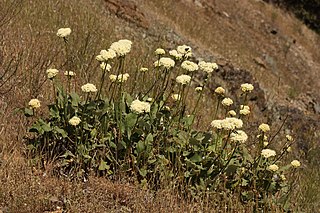
Eriogonum is a genus of flowering plants in the family Polygonaceae. The genus is found in North America and is known as wild buckwheat. This is a highly species-rich genus, and indications are that active speciation is continuing. It includes some common wildflowers such as the California buckwheat.

Coastal sage scrub, also known as coastal scrub, CSS, or soft chaparral, is a low scrubland plant community of the California coastal sage and chaparral subecoregion, found in coastal California and northwestern coastal Baja California. It is within the California chaparral and woodlands ecoregion, of the Mediterranean forests, woodlands, and scrub biome.

Eriogonum crocatum, the Conejo buckwheat or saffron buckwheat, is a species of Eriogonum, or wild buckwheat. It is endemic to the Conejo Valley and surrounding regions in Ventura County, California It grows on open, dry hillsides, often in crags in rock faces.

Eriogonum nudum is a perennial shrub of the wild buckwheat genus which is known by the common name naked buckwheat or nude buckwheat.

Rhus integrifolia, also known as lemonade sumac, lemonade berry, or lemonadeberry, is a shrub to small tree. It is native to the Transverse and Peninsular Ranges and the South Coast regions of Southern California. This extends from Santa Barbara County and the Channel Islands to San Diego County and extending into north-central Pacific coastal Baja California and its offshore islands such as Cedros Island.
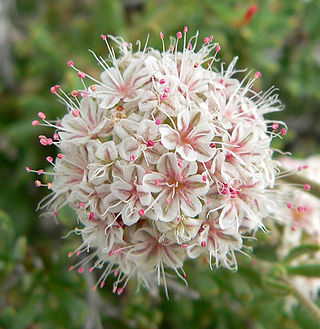
Eriogonum fasciculatum is a species of wild buckwheat known by the common names California buckwheat and flat-topped buckwheat. Characterized by small, white and pink flower clusters that give off a cottony effect, this species grows variably from a patchy mat to a wide shrub, with the flowers turning a rusty color after blooming. This plant is of great benefit across its various habitats, providing an important food resource for a diversity of insect and mammal species. It also provides numerous ecosystem services for humans, including erosion control, post-fire mitigation, increases in crop yields when planted in hedgerows, and high habitat restoration value.

Smith's blue butterfly, Euphilotes enoptes smithi, is a subspecies of butterfly in the family Lycaenidae. This federally listed endangered subspecies of Euphilotes enoptes occurs in fragmented populations along the Central Coast of California, primarily associated with sand dune habitat in one case with a dune-based Maritime Coast Range Ponderosa Pine forest in the Carbonera Creek watershed in Santa Cruz County. The range of E. e. smithi is from Monterey Bay south to Punta Gorda.

In biogeography, a native species is indigenous to a given region or ecosystem if its presence in that region is the result of only local natural evolution during history. The term is equivalent to the concept of indigenous or autochthonous species. A wild organism is known as an introduced species within the regions where it was anthropogenically introduced. If an introduced species causes substantial ecological, environmental, and/or economic damage, it may be regarded more specifically as an invasive species.
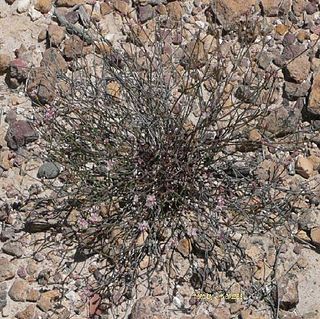
Eriogonum apricum is a rare species of wild buckwheat known by the common name Ione buckwheat. It is endemic to Amador County, California, in the United States.

Eriogonum arborescens is a species of wild buckwheat known by the common name Santa Cruz Island buckwheat.

Eriogonum cinereum is a species of wild buckwheat known by the common names coastal buckwheat and ashyleaf buckwheat.

Eriogonum davidsonii is a species of wild buckwheat known by the common name Davidson's buckwheat. This plant is native to the southwestern United States and northern Baja California. It grows in sandy or gravelly soils, mixed grassland, saltbush, chaparral, sagebrush communities as well as oak and montane conifer woodland. It is a spindly annual herb growing up to 40 centimeters in height. Leaves are fuzzy, basal, and round with wavy or wrinkly margins fuzzy. They are two centimeters wide. The plant is variable in appearance, but is usually erect with thin, naked, neatly branching stems bearing clusters of tiny flowers at widely spaced nodes. Each flower is about 2 millimeters wide, bell-shaped, and can be white, pink or red. Flowering occurs May to September.

Arctostaphylos myrtifolia is a rare species of manzanita known by the common name Ione manzanita. It is endemic to the Sierra Nevada foothills of California. It grows in the chaparral and woodland plant community on a distinctive acidic soil series, an oxisol of the Eocene-era Ione Formation, in western Amador and northern Calaveras counties. There are only eleven occurrences, of which three have not been recorded since 1976. This is a federally listed threatened species.
Eriogonum deserticola is a species of wild buckwheat known by the common name Colorado Desert buckwheat.

Eriogonum luteolum is a species of wild buckwheat known by the common name goldencarpet buckwheat. It is native to many of the mountain ranges of California and southern Oregon, including the Sierra Nevada, Cascades and California Coast Ranges. It grows in mountain and foothill habitat, such as forest and woodland, on granite and sometimes serpentine soils.
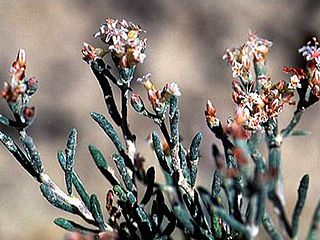
Eriogonum pelinophilum is a rare species of wild buckwheat known by the common name clay-loving wild buckwheat. It is endemic to the state of Colorado in the United States, where it is known from only two counties. The most recent estimates available suggest there are 12 occurrences in existence for a total of about 278,000 individual plants in Delta and Montrose Counties. At least 7 occurrences observed in the past have not been relocated but are not yet believed extirpated. This plant is federally listed as an endangered species of the United States.
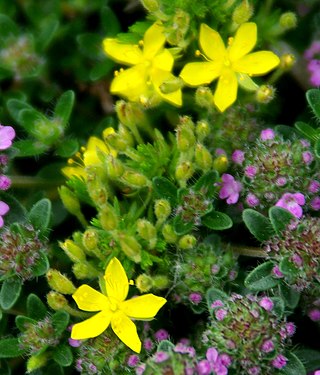
Hudsonia ericoides is a species of flowering plant in the rock-rose family known by the common names pine barren goldenheather, false heather, and golden-heather. It is native to eastern North America, where its distribution extends down the east coast from Newfoundland to Delaware, with a disjunct population in South Carolina.

Eriogonum soredium is a species of wild buckwheat known by the common name Frisco buckwheat. It is endemic to Utah in the United States, where it is known only from Beaver County. There are four populations, all located in the San Francisco Mountains. It is a candidate for federal protection.

Eriogonum elongatum, commonly known as longstem buckwheat or wand buckwheat, is a species of wild buckwheat native to coastal southern and Baja California.





















